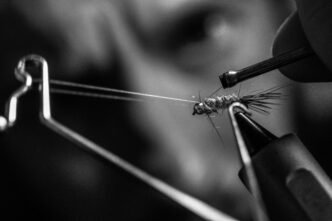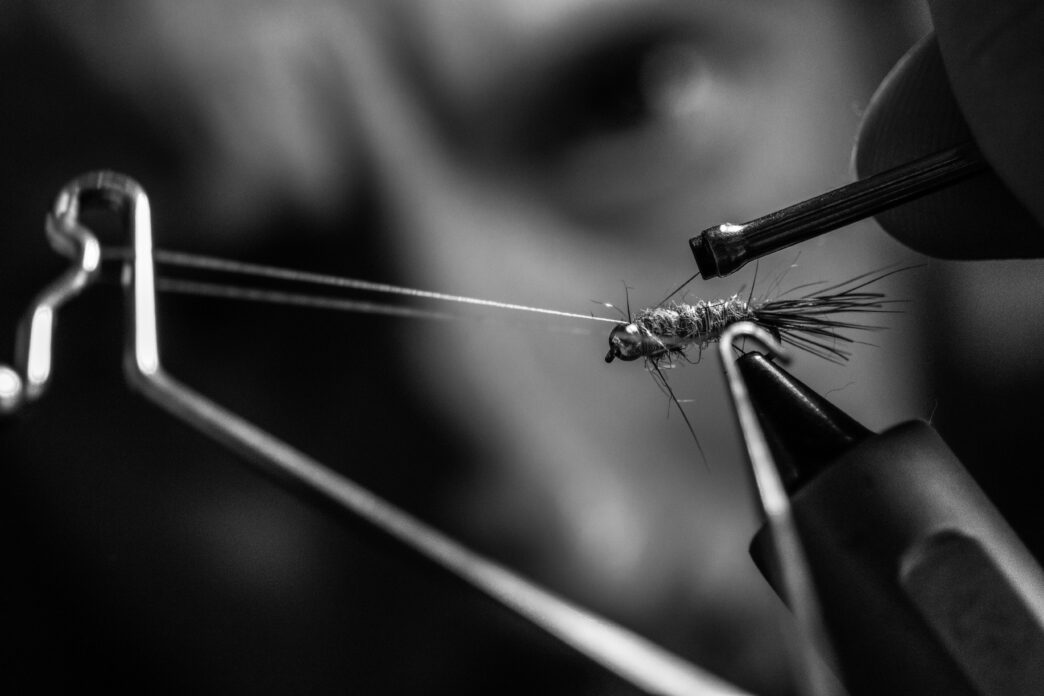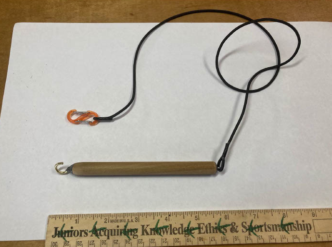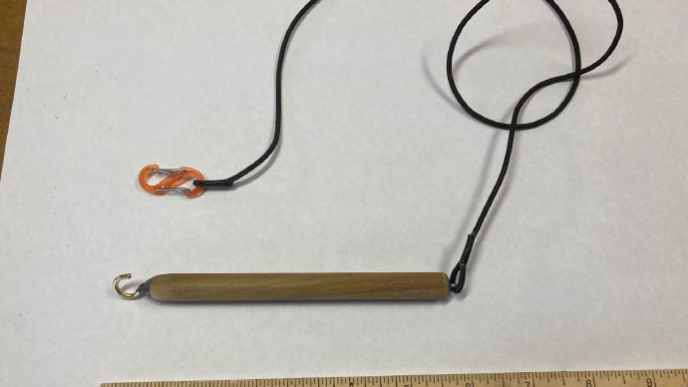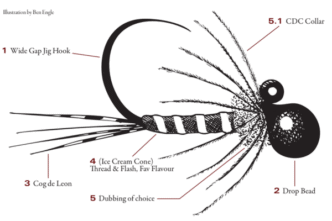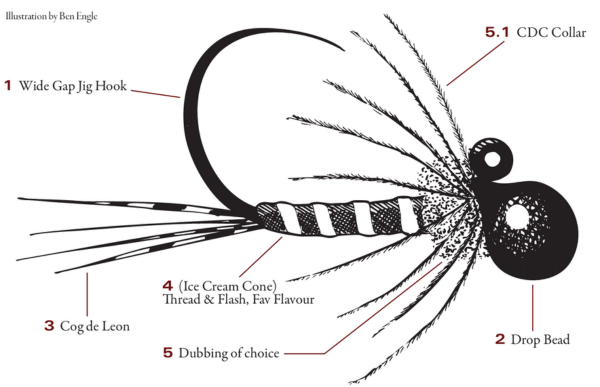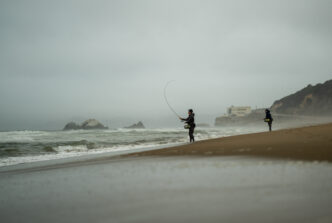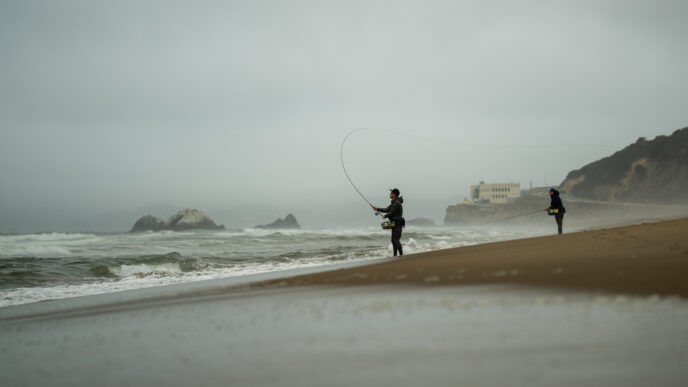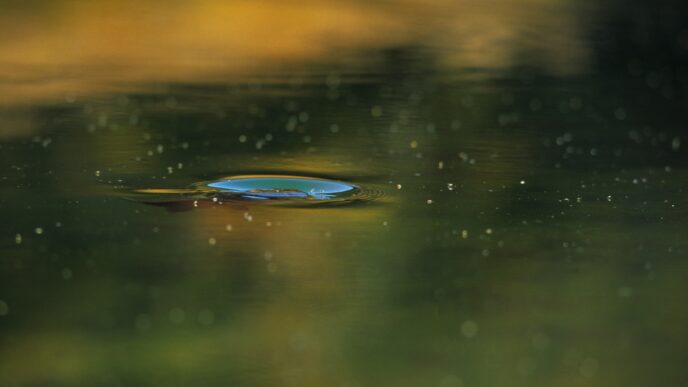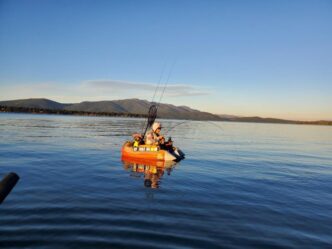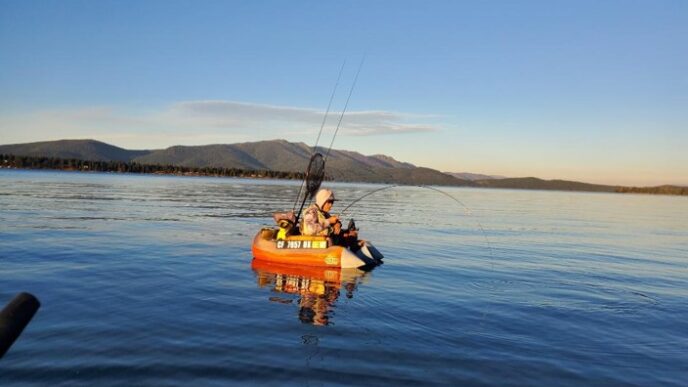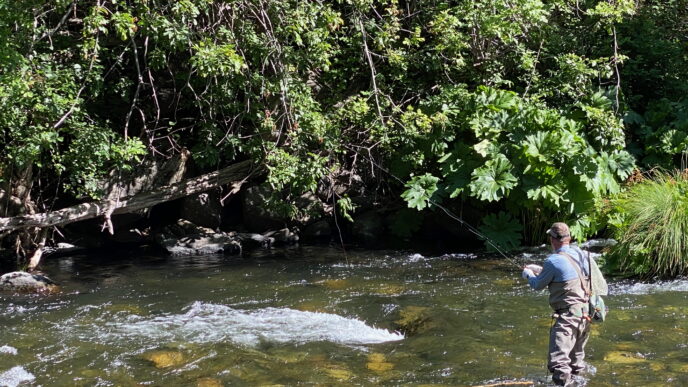When I began tying flies in my early teens in the 1970s, it was an art form of ostensibly open horizons, yet one limited by a scarcity of available tools and materials. Of course we didn’t realize this at the time, and generally found what was available to be largely functional and served our purposes. There were relatively few patterns in those days, and most of us spent our time at the vise tying a half dozen of the most popular flies. These bugs did the job when fished well, and we were satisfied with the process. Then the sport of fly fishing began to see an escalation of interest and innovation, perhaps most notably initiated by Doug Swisher and Carl Richard’s groundbreaking book, Selective Trout. First published in 1971, this classic rocked my world, changing forever the way I thought about the sport for which I had such passion. Its emphasis on specific insect fly design fired my imagination and introduced me to an aquatic world far beyond anything I knew to exist.
When I, for the first time, realized the complexity of the trout’s diet in my local streams, my mind began to swim with the possibilities, fueled by the innovative fly designs of Swisher and Richards. I began to seine trout stream insects and was amazed at the diversity each sampling revealed and how different the species could vary, even in streams that were in close proximity. In the relative blink of an eye, I was transformed from an ardent fly fisherman who tied his own flies to a fly tier who zealously sought to understand aquatic insects—their life stages and what each species possessed that triggered a feeding response from the trout. At that moment, for me, fly tying morphed from being a fun facet of my fly fishing life to an integral part of the experience, rivaling the importance of any rod, reel, fly line, or leader. I recognized that tying was not necessarily more important than those things … it was just what captured the creative part of my mind and led me down a path that continues to fascinate and challenge me to this day.
Shortly thereafter, I took a job at The Fly Shop in Redding, the first five years of which were spent as a guide on local waters. I learned more stream craft in that half-decade than probably all of the years since. I needed to produce for clients on a daily basis on waters like Fall River and Hat Creek, whose slow flows harbored fish that were among the most selective in the nation. Guiding an average of four days a week left three days to fish on my own, time which was never wasted. I fished long and hard on those days off, and while learning the finer points of reading water might arguably have offered the most important lessons to this trout bum and guide, figuring out the most effective flies was what kept me up at night. Time and again, I would cast over rising trout at Carbon Bridge on Hat Creek, often with disappointing results. I knew my presentations were spot on, with four to six feet of 7X allowing for perfectly drag-free drifts. So why was I getting so many refusals?
I consider myself fortunate to have spent many of those early days on the same waters as Bob Quigley, whom I still consider to be one of the top spring creek fly-tying innovators of the West Coast, if not the nation. Sadly, Bob is no longer with us, but his patterns remain mainstays for anglers everywhere. I was exposed to his creative genius in creating flies that imitated mayfly life stages that many people had no idea even existed at the time. Quigley Cripples, Paranymphs, and endless Paradun and spinner variations proved shockingly effective in duping even the most discerning of fish. As a guide, these flies were like magic, and in short order, the many frustrating refusals were a distant memory. Confidence replaced exasperation—it was like being handed the keys to the kingdom. If I saw a fish rise, I knew a client could and likely would hook it, no small feat on the weed-choked flats of Hat Creek.
It was during these long summer days that I began wandering my own creative tying path, diligently taking time during the most productive hatches to seine emerging insects, as well as netting bugs in fast-flowing, well-oxygenated riffles. What I found fascinated me, and I strove—in form, motion and color—to imitate what I felt the fish were seeing. I came to recognize when trout keyed on emerging PMDs to the exclusion of all else or rose just as selectively to tiny BWO spinners, and with Bob’s flies as a foundation, I began forming my own thoughts and observations into patterns that were different than what was available at the time. Many of my earlier innovations were nymphs, based on watching diverse species as they struggled in a seine, Petri dish, or the water cupped in my hand. I tended towards wanting to create a somewhat detailed illusion of life, unafraid of designing in more anatomical “triggering” features than were common in the flies of that time. Even on small nymphs, I routinely added legs and gills and shiny wingcases, features which many thought to be unnecessary and superfluous. Yet in my first such patterns, flies that came to be known as the Poxyback series of mayfly nymphs, the fish proved otherwise.
I’m sometimes asked how I approach creative fly design … what is it exactly that goes through my mind as I sit down at the vice to come up with a new fly? It’s an interesting question, and when I look back at over 50 years of tying evolution, a few things stand out.
First, there has to be time on the water, whether fishing or just observing the fascinating, constantly changing world of the trout. Without that, any attempts at creativity fall flat. For me, there has to be a motivation, a specific inspiration from something I’ve watched unfold on the stream.
Some of my most productive creations have come from dismal failure on the water.
The Missing Link, one of my most popular dry flies, came about after years of getting my hat handed to me by the big rainbows of the Lower Sacramento River as they sipped dead and dying caddis on endless summer evenings. Years of inconsistent success finally prodded me to really try and visualize what the fish were seeing in these bugs and use whatever materials necessary to try and recreate the look. Unusually, my first attempt turned into the final product!
Second, I encourage tiers to approach the vise with an idea gleaned from water time and try their best not to simply recreate a slightly different version of something that has already been done. Certainly, it is fine to borrow ideas and techniques from other tiers and patterns and arrange them in new and unique ways, but in my experience, the most revolutionary changes have come from a place far outside the “normal” box. Remember when metal beadhead nymphs first hit fly shops a few decades ago? Don’t allow your mind to get stuck in the rut of what everyone else is doing or pigeonhole certain materials as only being for specific uses. CDC became popular for making wonderful dry flies, but as intrepid tiers then discovered, it also makes for a killer addition to nymphs. Be clear in your mind what it is you are trying to accomplish with a new pattern—are you trying to create a realistic profile? Design in material motion? Imitate the most visually arresting part of a particular insect’s life stage or emergence? In each case, free yourself up to consider what will sometimes be unconventional materials or tying methods. This is often where true innovation is born.
Third, never forget that you are attempting to emulate a living creature and that all such creatures are endowed with their own unique attributes of life. I like to call it designing in fire and light. So often in the emergence stages, insects will release gases that create a highly reflective “flash” that I firmly believe trout key in on. Consider this when tying, and think about the wealth of reflective materials available to today’s tiers … try one of them that you feel might work, even if it is not currently in widespread use. Similarly, consider how a mayfly nymph’s wingcase darkens just prior to emergence or how most stonefly nymphs are darkly mottled on their dorsal surfaces yet light-colored on their bellies. Designing contrasting hues into flies often seems to trigger fish into an eating response, whether it is created with a flashy material, a dark wingcase on an otherwise light-colored nymph, a nymph designed to flicker dark/light/dark as it rolls in heavy current, or even something as simple as a brightly-colored collar on a darker Perdigon pattern.
Finally, learn to welcome intuitive thoughts as they spring to your mind, often unbidden, in the process of tying creatively. Often we dismiss these passing notions as odd and useless, and this can be a mistake. I suspect they come from that subconscious part of our brain we don’t control, a place that has watched our world unfold around us all our lives. This includes witnessing things occurring on rivers as we fish; a long-forgotten tying video; or a material we glanced at in the fly shop but at the moment had no relevant context in which to consider it. For reasons we can only guess at, months or even years later, that subconscious spits out a memory that flits across the periphery of our vision as we sit at our vise. Ignore it at the risk of missing something truly important.
So after all these years, do I still believe that the ability to read water, “seeing” where fish will be sitting in any given body of water at any given time, is more important than the fly being used?
I prefer to think of them as equal partners in the beautiful dance that is fly fishing.



